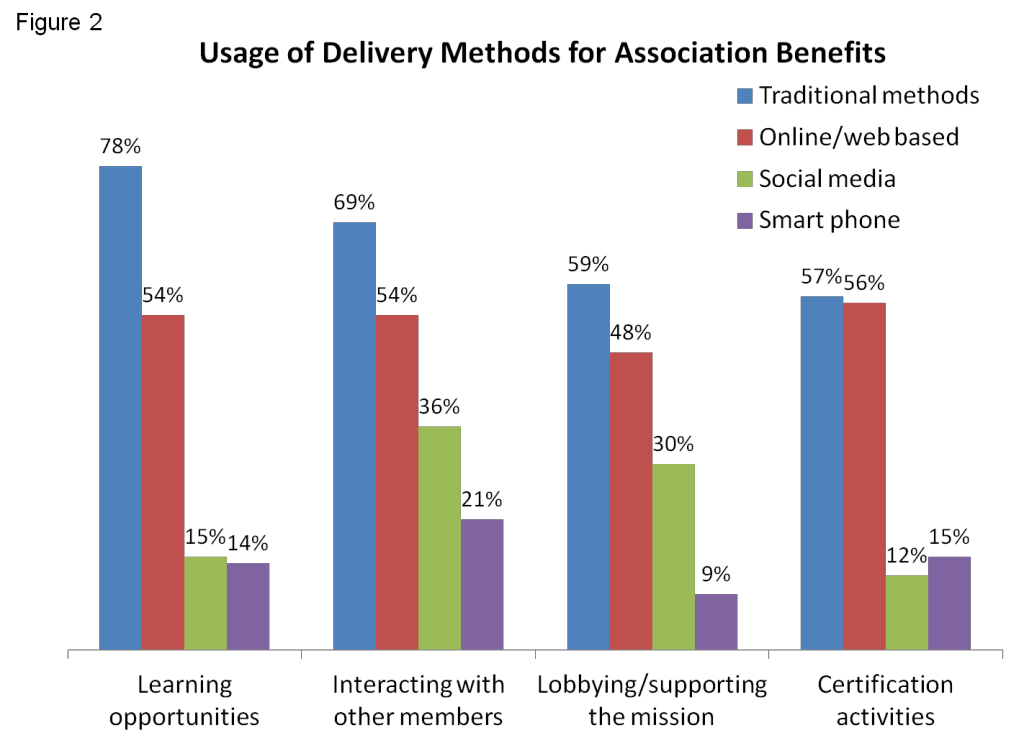Associations play a critical role in helping Americans support the causes and industries they believe in, interact with others with common interests, and continue their education. Associations must provide this value in a way members prefer or risk losing support. A recent survey conducted by Rockbridge Associates with a cross-section of U.S. adults indicates that associations are not necessarily meeting members’ expectations in the use of technology to deliver content and communicate with them. As a new generation of association members with different expectations enters the mainstream, and as current cutting edge technologies gain wider acceptance, associations will need to adapt to ensure support for their mission.
The Current State of Membership
Associations come in two varieties, those individuals belong to for personal reasons (e.g., AARP) and those that are related to an individual’s career or business (i.e., a professional or trade association).
- In 2011, nearly one-in-three Americans (30%) belongs to an association for personal reasons. This is up slightly since 2009 when only a quarter of Americans (25%) were members.
- This year, slightly more than one-in-ten Americans (13%) belongs to an association related to their career, with 83% of those involved in a professional association and 17% in a trade association. This is down slightly compared to two years ago when 16% of Americans belonged to a professional or trade association, likely due to economic conditions.
Association members tend to believe their association membership is highly valuable, with 71% of association members saying the value they receive is “excellent” or “very good.” This is up since 2009 when only 66% felt similarly, confirming that associations are succeeding in remaining relevant. However, professional/trade association members find less value in their membership than those who are part of associations for personal reasons (59% vs. 74%, respectively), showing that more can be done to better serve these members.
How Associations Use Technology
Associations can take advantage of technology to add value to membership and make it easier and more convenient for members to participate in association activities. Nevertheless, only half of association members (52%) believe their association’s use of technology to serve them is “excellent” or “very good,” and more specifically, three-in-ten (29%) feel associations use technology “too little.”
Compared to two years ago, associations have not changed how they communicate with members dramatically with one exception: the use of social networking sites by members nearly tripled from 12% in 2009 to 33% in 2011 (see Figure 1).
The usage of social networking is more pronounced among younger members, aged 18-39 years, with 56% of them using social networking sites to communicate with their associations, compared to only 21% of 40-59 year olds and 14% of 60+ year olds. Social networking sites are the second most used communication method among the younger age group, only surpassed by email. Email continues to be the most popular method members use to communicate with their associations, followed by in-person meetings and telephone. Nearly all association members (92%) feel the amount of email they receive from their association is “just right”.
Associations typically offer members learning, networking, lobbying, and certification opportunities as part of their activities, and members can engage in them in different ways. Delivery methods include traditional (e.g., in-person), online/web-based, social media, and smart phones. The most popular engagement method across activities continues to be traditional methods, but technology-driven channels are commonly used as well (see Figure 2).
With the prevalence of email to communicate for networking and lobbying efforts and webinars for learning and certification activities, online/web-based methods are used by about half of members for all of these activities. Approximately a third of members use social media for networking (36%) and lobbying (30%). Members use smart phones most for networking (21%), but more than one-in-ten use them for learning (14%) and certification (15%), likely through technologies like podcasts.
Even though traditional methods are currently used by a majority of members for each of the activities offered by associations, the gap between traditional and online/web-based methods narrows significantly when members are asked their preferred method for delivery (see Figure 3).
This is particularly true of learning and certification activities; nearly equal numbers prefer traditional (47%) and online/web-based methods (44%) for learning activities, and more than half of members (55%) prefer online/web-based delivery for certification compared to only a third (34%) who prefer traditional methods. One reason for the gap between usage and preference is most likely that associations are not offering enough technology-based options.
Less common delivery methods still have a following that associations need to be cognizant of when considering delivery methods to offer members. Two-in-ten members (19%) prefer social media for networking, and 11% prefer it for lobbying activities. These activities lend themselves well to the social aspects of the medium, and allow the association to reach more broadly than traditional methods. One-in-ten members lean towards smart phones for certification activities, most likely through podcasts, showing members’ desire for convenience.
Associations constantly communicate with their members about their educational content, networking opportunities, and lobbying efforts to maintain members’ active participation and support for their mission, but must do so in a way that is convenient and preferred by members. New technologies, like social media and smart phones, open up opportunities for associations to interact with members in ways they are already communicating and prefer, and associations need to more effectively incorporate them and other new technologies into their activities to maintain member support.
About this Study:. Rockbridge surveyed 230 members of U.S. associations from a national online panel. The results were weighted to match the demographic representation in the U.S. Census. The margin of error on the findings reported here is plus or minus 6 percentage points. Rockbridge is a custom market research firm specializing in technology issues and research for services firms, including many associations.



